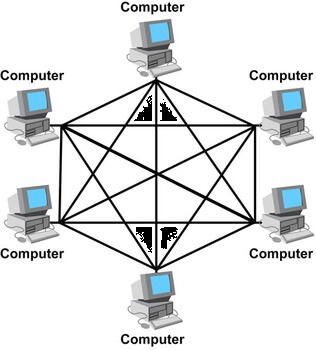Network topology refers to the arrangement of nodes, devices, and communication channels in a computer network. There are several types of network topologies, including bus, star, ring, mesh, and tree. Each topology has its own advantages and disadvantages, depending on the network's size, scalability, and fault tolerance requirements.
Network topology has basically 5 types:
BUS TOPOLOGY - A bus topology connects all devices to a single communication channel called a bus. Data is transmitted along the bus to all connected devices, and each device listens for its specific address. This topology is simple and cost-effective for small networks, but it can suffer from congestion and is not scalable to larger networks.
Source - https://www.javatpoint.com/
STAR TOPOLOGY - A star topology connects all devices to a central hub or switch. Data is transmitted from the sender device to the hub, which then broadcasts the data to all other devices. This topology is widely used in LANs and is scalable, fault-tolerant, and easy to manage. However, it requires a larger number of cables and devices, and a single point of failure in the hub can disrupt the entire network.
Source - https://www.javatpoint.com/
RING TOPOLOGY - A ring topology connects all devices in a circular loop, where each device is connected to its neighboring devices. Data is transmitted in one direction along the loop, and each device repeats the data to the next device until it reaches its destination. This topology is simple and efficient for small networks, but it can suffer from congestion and a single faulty device can disrupt the entire network.
Source - https://www.javatpoint.com/
MESH TOPOLOGY - A mesh topology connects all devices in a fully interconnected network, where each device is connected to every other device. Data can be transmitted through multiple paths, making this topology highly fault-tolerant and scalable. However, it is complex and expensive to implement, and requires a large number of cables and devices.
Source - https://www.javatpoint.com/
TREE TOPOLOGY - A tree topology connects devices in a hierarchical structure, where branches of devices connect to a single root node or hub. Data is transmitted from the sender device to the hub, which then broadcasts the data to all other devices in the branch. This topology is scalable and fault-tolerant, and it allows for easy management and troubleshooting. However, a single point of failure in the root node can disrupt the entire network, and the network's size and complexity can affect its performance.
Source - https://www.javatpoint.com/
In summary, network topology is an important aspect of computer networks that can affect the network's performance, scalability, and fault tolerance. Choosing the right topology depends on the network's requirements, size, and cost constraints. It is also important to consider network security and management issues when designing and implementing a network topology.






